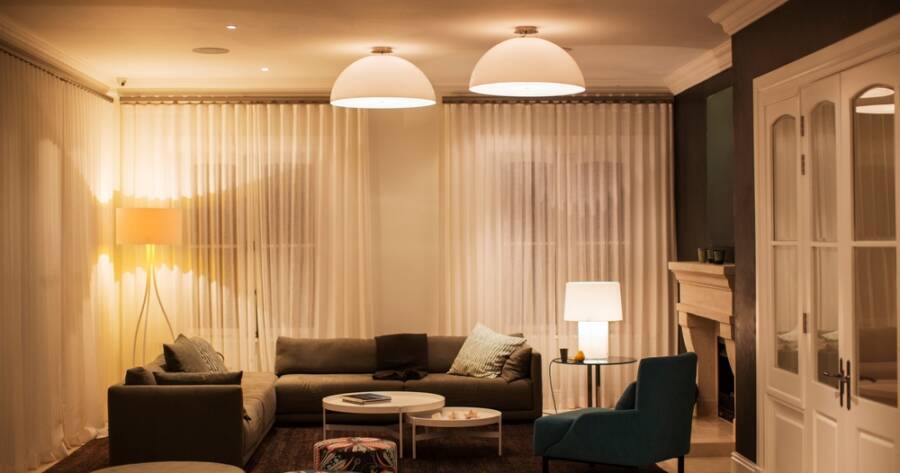Lighting does more than brighten a room—it shapes mood, function, and atmosphere. The right lighting can make a kitchen feel energized, a bedroom feel calm, or a living room feel inviting. Each space in your home requires a different balance of ambient, task, and accent lighting to achieve both comfort and purpose. Understanding how the layers work together allows you to create spaces that not only look beautiful but also support the way you live every day.
Living Room: Warm, Layered Lighting
The living room is a multifunctional space for relaxation, entertainment, and gathering. A layered lighting approach works best here, combining ambient, task, and accent lighting.
- Ambient lighting: Start with a ceiling fixture such as a chandelier, flush-mount, or recessed lights to provide general illumination.
- Task lighting: Add table lamps or floor lamps near seating areas for reading or other focused tasks.
- Accent lighting: Highlight artwork, architectural features, or shelving with wall sconces or track lights to create visual interest.
Using dimmers in the living room allows you to adjust the lighting for different moods, whether it’s movie night or a lively gathering.
Kitchen: Bright, Functional Lighting
The kitchen is a workspace, so it needs bright, functional lighting that supports safety and visibility.
- Ambient lighting: Recessed ceiling lights or flush-mount fixtures provide overall brightness.
- Task lighting: Install under-cabinet lighting to illuminate countertops for cooking and food prep. Pendant lights over islands or peninsulas also provide focused task lighting while adding style.
- Accent lighting: Use small spotlights or LED strips to highlight open shelving or display cabinets, adding depth and dimension to the kitchen.
Cooler, whiter bulbs (4000K–5000K) are ideal in kitchens to simulate daylight and keep the space feeling fresh and clean.
Bedroom: Soft, Relaxing Lighting
Bedrooms are a place to unwind, so the lighting should create a calm and cozy atmosphere.
- Ambient lighting: A ceiling fixture, such as a chandelier or flush-mount, sets the tone for the room.
- Task lighting: Bedside table lamps or wall-mounted reading lights make it easy to read or relax in bed.
- Accent lighting: Consider adding string lights, fairy lights, or subtle LED strips around headboards or dressers for a touch of warmth and ambiance.
Opt for warm light bulbs (2700K–3000K) in bedrooms to create a soft, inviting glow that promotes relaxation.
Bathroom: Bright and Functional Lighting
Bathrooms require a mix of practical and flattering lighting, especially around mirrors.
- Ambient lighting: Ceiling fixtures like flush-mounts or recessed lights provide general illumination.
- Task lighting: Install vanity lights or sconces on either side of the mirror at eye level to minimize shadows on the face. This is especially important for tasks like shaving or applying makeup.
- Accent lighting: Consider toe-kick lighting under vanities or in shower niches for a subtle, modern touch.
Ensure bathroom lighting is bright enough for safety but warm enough (3000K–4000K) to avoid harshness.
Dining Room: Elegant, Focused Lighting
The dining room is all about creating ambiance and highlighting the dining table.
- Ambient lighting: A chandelier or pendant light over the table serves as the room’s focal point.
- Accent lighting: Add wall sconces, buffet lamps, or recessed lighting to create depth and a welcoming atmosphere.
- Task lighting: While not always necessary, consider a dimmer switch to adjust lighting for meals or entertaining.
Home Office: Focused and Balanced Lighting
In a home office, lighting plays a crucial role in boosting concentration, reducing eye strain, and maintaining energy throughout the day. Natural light should be maximized whenever possible, as it supports alertness and mood. For ambient lighting, recessed or overhead fixtures can evenly illuminate the space without glare.
Task lighting, such as adjustable desk lamps with LED bulbs in the 4000K–5000K range, ensures clarity for reading or computer work. Adding soft accent lighting—like a floor lamp or wall sconce—can balance the brightness and make the space feel more comfortable during late hours.
Light Up Your Home: The Power of Room-Specific Lighting
Choosing the right lighting for each room enhances functionality, style, and comfort. By combining ambient, task, and accent lighting thoughtfully, you can create spaces that are both beautiful and practical. Whether you’re brightening up the kitchen or adding a warm glow to the bedroom, the right lighting makes all the difference in how a space feels and functions.
